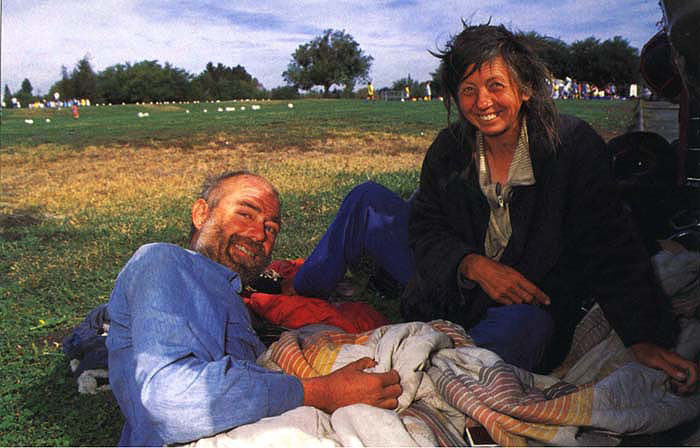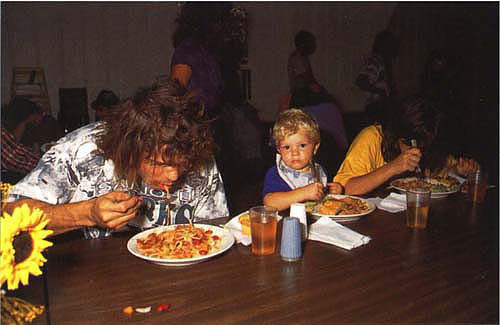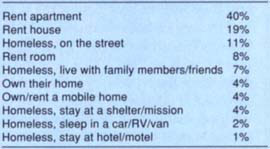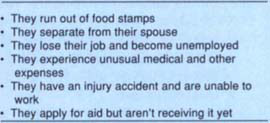All Issues
Hunger in the midst of affluence: Task force combats hunger in Contra Costa County
Publication Information
California Agriculture 48(7):11-13.
Published December 01, 1994
PDF | Citation | Permissions
Abstract
In Contra Costa County, one of the most affluent counties in California, an increasing number of men, women and children line up for free food every day. Research conducted over the past 7 years has shown that these people, many of them families, are turning to emergency food pantries and soup kitchens to avoid hunger. This research has led to actions to alleviate the problem.
Full text
Even counties thought to be invulnerable are showing signs of hunger and homelessness. Here, a homeless couple in Contra Costa County lives in a park just yards away from a children's soccer game.
Despite the abundant output of the state's agricultural industry, more than 3.6 million Californians, or one in eight people, are at risk of going to bed hungry. Of the state's children, one in five are at risk. This population does not have enough money to meet basic living expenses — including food. They live at or below poverty line, the income level determined by the federal government as the minimum necessary to meet life's basic needs. The 1994 annual poverty threshold for a family of three is $12,320. Yet even this amount does not guarantee adequate food, either in quantity or quality, to provide a healthful diet. For the majority of people living at or below poverty level, there is simply not enough money to pay for housing, utilities, transportation, clothing, laundry, supplies and food throughout the month.
In Contra Costa County, considered one of the most affluent counties in the state, 57,000 people lived in poverty in 1990, according to the latest census. Although the view from the freeway gives the impression of success and vitality, it has long been evident to local health and social service professionals that many residents suffer the effects of poverty. In 1987, a Hunger Task Force was formed (see box, p. 17) to document the nature and extent of hunger, and develop and implement strategies to alleviate the problem. This task force, composed of representatives from local private and public educational, health, social service and religious agencies undertook a research project to survey people standing in line for free food in Contra Costa County.
The Hunger Task Force undertook a systematic assessment of the county's hunger problem in 1987 and again in 1992. For both studies, they compiled county statistics indicating the number of people served by charitable and public food assistance programs from soup kitchens to school lunch programs. Task force members then interviewed more than 325 people who received free food from emergency food pantries, soup kitchens and USDA commodity distribution sites. These emergency food recipients were asked to provide information about their housing, health and general economic situations, as well as why they asked for help and how often they or members of their family went to bed hungry.
The results of the studies were disturbing. While the numbers of people going hungry do not nearly equal those of counties such as Los Angeles, which have large urban areas, it is evident that hunger exists and is increasing in an area previously considered immune to such problems. Emergency food pantries, which provide recipients with a 3-day supply of food, had already seen a 39% increase in the numbers they were serving from 1985–87; by 1987, they were serving 5,240 people per month. Three new soup kitchens opened that year, bringing to eight the total number of places where families could come for a hot meal. Of those eight, four served meals daily or during weekdays, while the other half offered meals much less often.
In 1987, these soup kitchens were already serving twice to three times the anticipated number of people — an estimated 900 per month. The USDA commodity distribution sites were handing out a relatively attractive basket of food, including 5-pound blocks of American cheese, to 13,000 people per month.
By 1992, the situation had worsened noticeably, especially for children. Although fewer people lined up for food dispensed at USDA sites (11,600 compared to 13,000 five years earlier) the food bags were smaller and inconsistent, often not including all the staples provided in the earlier bags. Soup kitchens were now serving an estimated 2,000 people per month. But the largest increase was borne by the food pantries, which served 11,000 people per month in 1992 — double the numbers served just 5 years earlier.
The profile of hunger
In 1992, children under 18 accounted for 43% of those who received free food, compared to 34% of recipients in 1987. This finding is consistent with a nationwide profile of free food recipients completed by the Second Harvest National Food Bank Network in late 1993 (see sidebar, p. 14). In Contra Costa in 1992, almost one in five beneficiaries was under the age of six. This is particularly disturbing since the effects of hunger, physical as well as psychological, can last a lifetime.
Asked how often they went hungry on a scale ranging from never to always, half of the adults reported going without food sometimes or often. Fifteen percent of children went to bed hungry at least on occasion, with some parents indicating this happened on a regular basis.
Neither the breakup of the nuclear family nor transience could explain the prevalence of hunger in Contra Costa in 1992. Two-parent families made up the largest group of people who sought food aid (table 1). Three-quarters of all recipients rented or owned housing (table 2). Almost all (98%) lived in the county, with half having lived in Contra Costa for more than 4 years.
The ethnic makeup of those who stood in line for free food in 1992 mirrored the ethnic makeup of the county's known poor. Whites represented the largest group, making up 45% of recipients. Blacks accounted for 36% of recipients, while Hispanics made up 16%, Asians 2% and Native Americans 1%. The largest discrepancy between emergency food recipients and the general poverty population was for Asians, who made up almost 10% of people in poverty, yet accounted for only 2% of those who sought emergency food. Further study is needed to determine if the emergency food network could do more to reach out to these communities in more culturally appropriate ways.
Increasingly, families are the most frequent participants in emergency food programs, with children making up almost half of those who receive free food.
The recipients' stated reasons for seeking food included losing their jobs or being injured and unable to work (table 3). The prevailing feeling was one of shame for needing free food. Many stated that they were “hard workers” who never dreamed they would come to rely on charity to feed their family.
Minimum wage is not enough
It is not hard to understand why someone would face household food shortages when trying to support a family of three on $657 a month, which was the average income for a family of this size in the 1992 study. This amount is 30% below the poverty level. It is expected to cover all living expenses for a month. In addition to food, this includes housing, utilities, supplies, clothing, transportation and child care costs. Most of these expenses are fixed costs; the rent is not negotiable with the landlord and bus fare is a set amount. After the bills are paid, there is often no money left for food.
As in other areas of the state, the average family spent almost half of its income on housing. Another 13% went to utilities, water and telephone. Since fewer than two in five emergency food recipients owned cars, they relied on walking or public transportation. Some recipients walked several miles to get a meal at a soup kitchen.
Even those working full time for minimum wage could not stay out of poverty. While slightly more than half (52%) of the adults surveyed were out of work, another 16% were employed at low-wage jobs ranging from factory and automotive jobs to child care. The remaining 32% were homemakers, students, retired or disabled adults. For those who did work, the mathematics were discouraging. The minimum wage is $4.25 per hour. Yet it would have to be $6.00 per hour for a family of three to be above the poverty line and able to afford life's basics.
The Food Stamp program is the USDA entitlement program meant to supplement a family's food budget to alleviate hunger. Yet over half of those who stood in line for free food also received food stamps every month. They still depended on charity because, for most food stamp recipients, one month's allocation is only enough to buy food for two weeks. The average monthly food stamp benefit for a family of three in Contra Costa is now $134, or 50 cents per meal per person.
Budget cuts in other social service areas have combined to make the situation even more dire. Recipients of free food who depend on Aid to Families with Dependent Children, Supplemental Security Income or Social Security benefits, have seen their benefits decrease during the last 5 years due to inflation and cuts in state spending.
Hunger increased in 1992
In 1992 Contra Costa food pantries distributed food to 125,000 people. More than 250,000 meals were served at soup kitchens. It is clear that food pantries and soup kitchens, most sponsored by religious and nonprofit organizations, are taking on a larger role in the battle against hunger. Yet, even though they serve as a crucial stop-gap, they cannot be considered the long-term solution to hunger.
Comparing data from the two hunger surveys yielded disturbing results. Emergency food pantries and soup kitchens served nearly twice as many people in 1992 as they did in 1987. Among their recipients were increasing numbers of children who went to bed hungry, as well as adults who found it necessary to skip meals. Clearly, both the number of people experiencing hunger and the severity of their need had grown — at a rate exceeding the capability of emergency food providers.
The choice between homelessness and hunger is a real one which many families confront constantly. In 1992 a quarter of food recipients were homeless, a small decrease from 1987, when 31% of recipients were homeless, living in a shelter, car, motel, or with family or friends. While this may strike one as an optimistic figure on the surface, it also suggests the possibility that many do not have enough money for both food and housing. When confronted with the difficult choice of spending their last remaining dollars on shelter or food, more are now choosing to stay housed as long as possible and taking their chances on handouts of food for themselves and their children. Although anyone can line up to eat at a soup kitchen when it's open, such facilities depend on charity and may run out of food. For the same reason, the food they offer may not be nutritionally adequate. While hungry people may obtain 3 days' supply of groceries at food pantries and USDA sites, they are restricted to receiving this benefit twice every 6 months or once a month, respectively. Clearly, charities cannot fulfill the food needs of any family or even any one individual.
Members of the Hunger Task Force
American Cancer Society
California Hunger Action Coalition
Church Women United
Contra Costa Food Bank
Contra Costa Child Care Council
Contra Costa County Community Services Department
Head Start Program
Contra Costa County Health Services Department
Child Health and Disability Prevention Program
Office for Service Integration
Prevention Program
Public Health Nursing
Senior Nutrition Program
Women, Infants, and Children (WIC) Program
Contra Costa Nutrition Council
Contra Costa County Social Services Department
Food Stamp Program
Office on Aging
Diablo Valley Dietetics Association
League of Women Voters
Loaves and Fishes Soup Kitchen
Mt. Diablo Unitarian-Universalist Church
University of California Cooperative Extension
Expanded Food and Nutrition Education Program
Volunteers of America
Research promotes hunger relief
The results of this research have been put to good use locally. Data from each report have been used by local providers of emergency food to expand services into identified areas of need. After discovering in the 1987 survey that food stamps were underutilized by emergency food recipients, task force members decided to initiate a food stamp outreach campaign. Contra Costa County was the only county in the state to receive federal matching funds to implement such a program. In its 2 years of existence, this program helped increase food stamp usage in Contra Costa by 64% compared to an average increase of 36% for the state.
The studies have also been the impetus behind expansion of local child nutrition programs. After reviewing the 1987 findings, the local school district with the highest rate of eligibility for free and reduced-priced school meals in the county reinstituted its school breakfast program. The next year an additional 10,000 needy students had breakfast available at school. The Hunger Task Force also succeeded in expanding summer feeding programs so that children had access to a nutritious meal when school was not in session. Since 1987, almost 1,000 additional children have begun participating in the Summer Food Program.
The Contra Costa County Food Bank has also responded to research results by starting the “Prepared Foods Program,” where trained food bank staff collect wholesome foods donated by restaurants, caterers and other commercial food service operations and take them to soup kitchens to feed the ever-growing number of guests. “Food for Children” is another program developed to meet the needs of preschool-aged children unable to participate in other food assistance programs. In this program, specially prepared bags of groceries are given each month to needy families with young children.
Efforts continue
Hunger Task Force members continue to promote and facilitate the expansion of publicly funded food assistance programs for children, pregnant and breast-feeding women, families and seniors. The University, through Cooperative Extension, has played, and should continue to play, an important and appropriate role in this effort. In the Contra Costa studies, the University's involvement was critical in providing the research tools enabling those concerned to do a credible job of documenting the problem and framing the issues. The survey tool used in the two studies was developed, tested and validated by Cooperative Extension, and has been used statewide.
Conditions change so that these programs will need continual support just to maintain an adequate level of service. Private agencies will continue to need technical information and training enabling them to meet the needs of the families who depend on them. A hunger survey is planned for 1997 to monitor the situation. Until economic conditions change, and counties are hunger-free, the need for these collaborative efforts is still there. The task force's accomplishments reflect the synergy of coordinated efforts reproducible anywhere.









